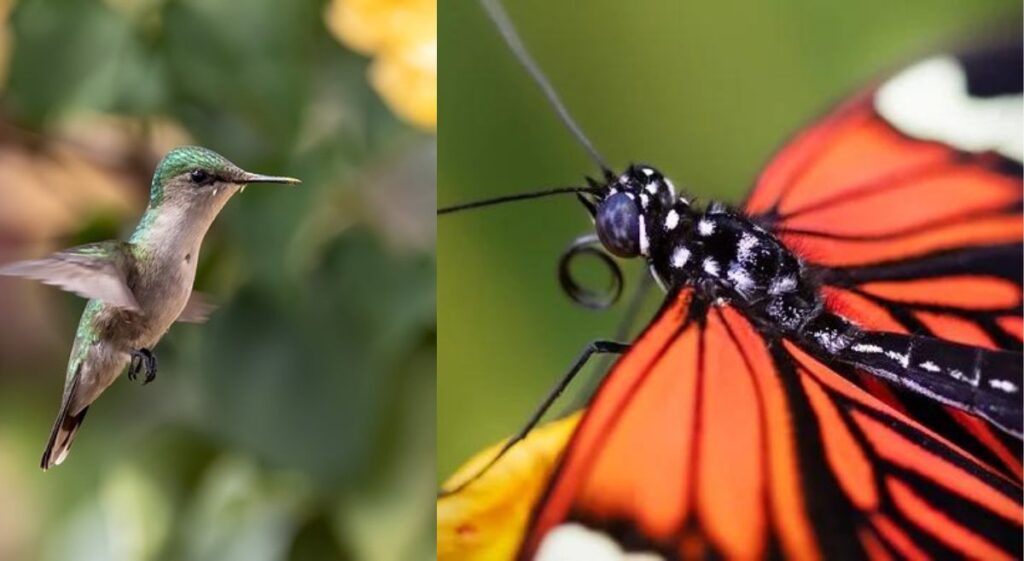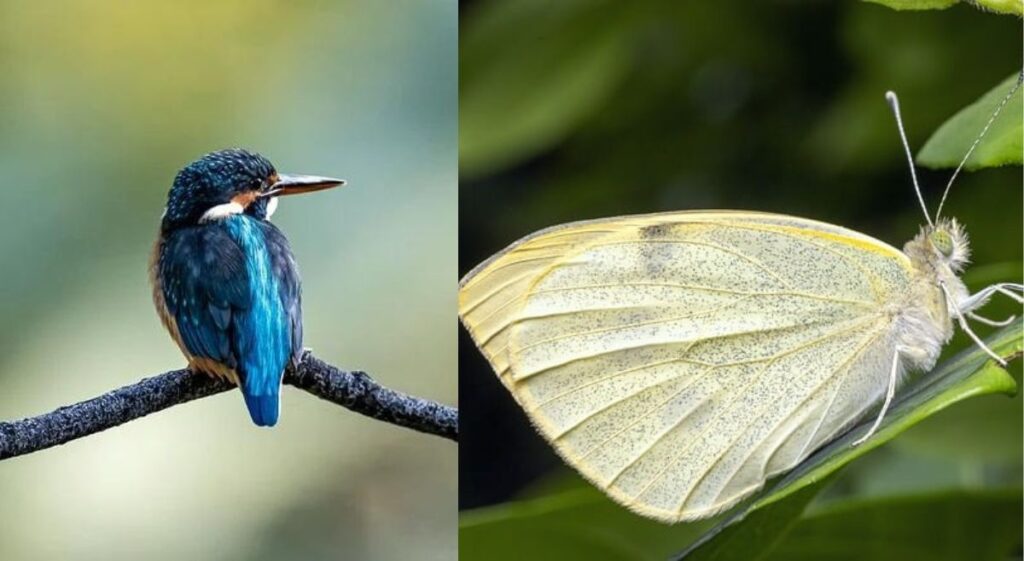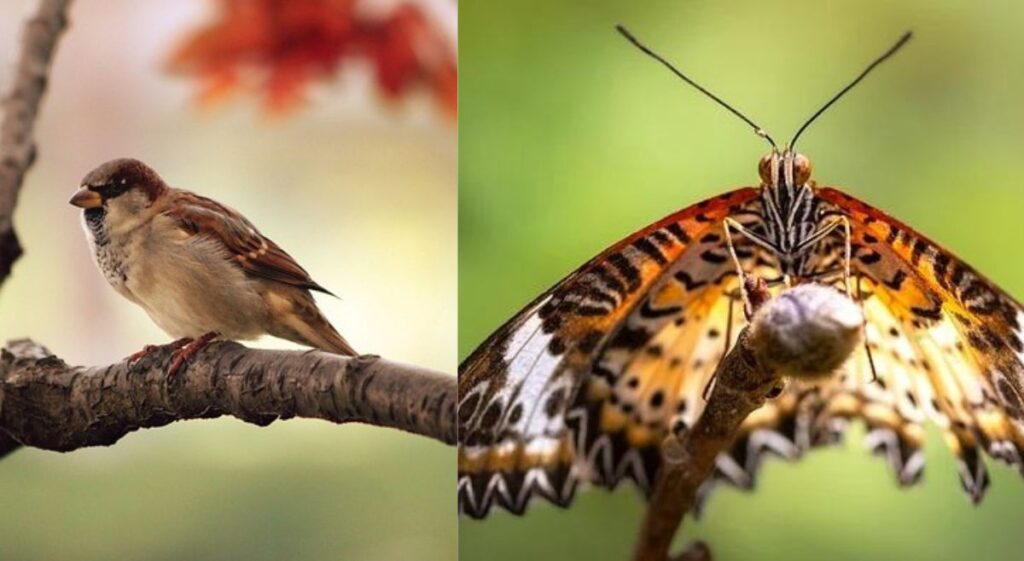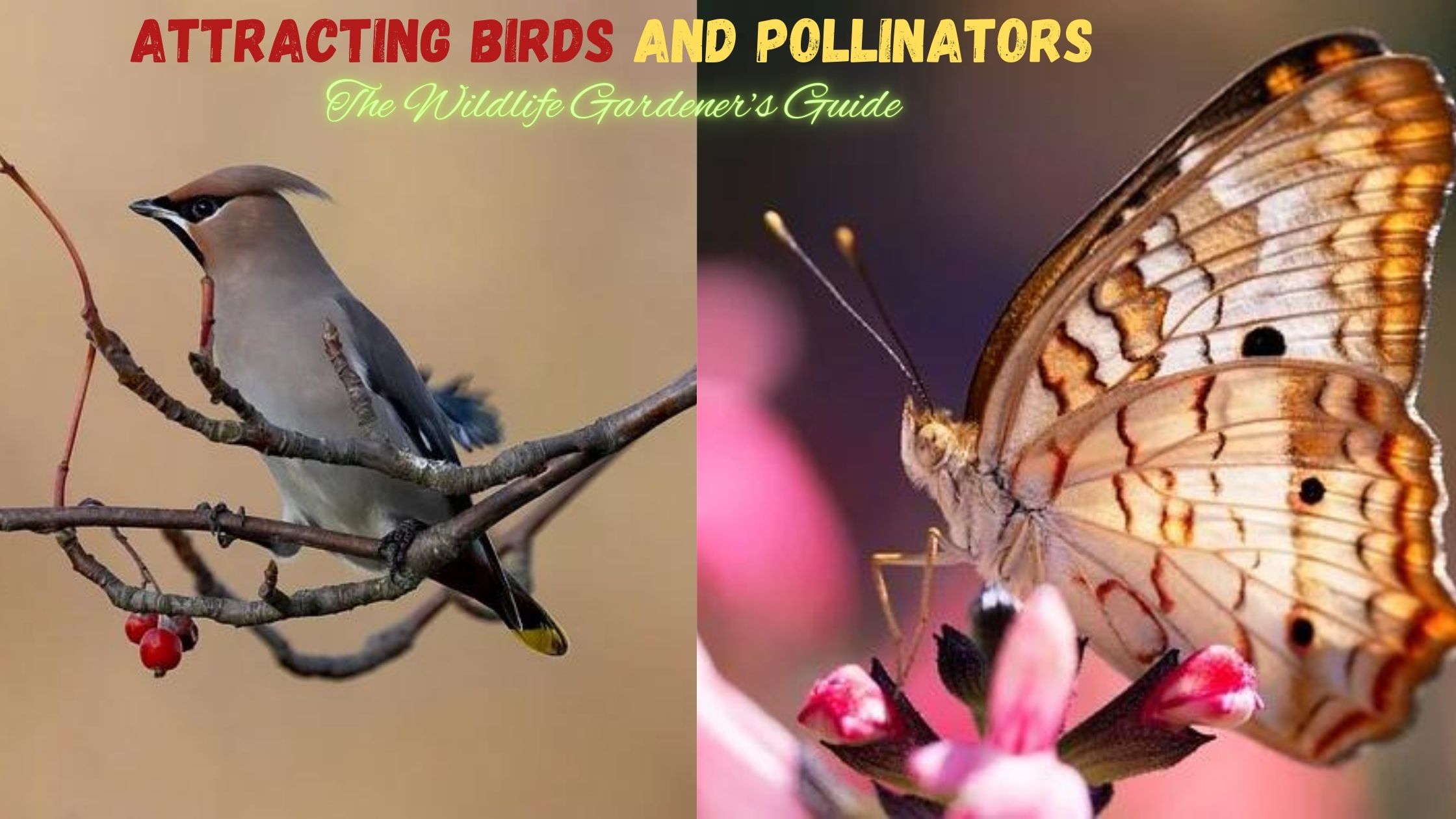Introduction
Attracting Birds and Pollinators: The Wildlife Gardener’s Guide

Enhancing your outdoor space while contributing to the local ecosystem can be achieved by creating a garden that attracts birds and pollinators. These creatures, including birds, bees, butterflies, and other pollinators, play a vital role in sustaining the environment through plant reproduction. This guide will explore how to design a wildlife-friendly garden that welcomes these essential creatures into your yard, enriching both your outdoor space and the natural world around you..
Tips for Attracting Birds and Pollinators
1. Native Plant Selection:
- Start your wildlife garden with native plants that thrive in your region’s climate and soil conditions, offering the best food sources for local wildlife.
- Examples include Eastern Redbud for hummingbirds and bees, Milkweed for monarch butterflies, and Coneflowers beloved by bees and birds.
2. Water Sources for Hydration and Bathing:
- Provide water sources like birdbaths, shallow dishes, or small ponds for birds and pollinators to drink and bathe.
- Keep the water clean and refreshed regularly to prevent pests.
- Consider a shaded birdbath, a shallow fountain or pond with easy access edges, or dripping water features to attract hummingbirds.
3. Shelter and Nesting Sites for Protection:
- Create natural layers of shelter and nesting opportunities with plants of varying heights, especially dense shrubs, trees, and vines.
- Offer birdhouses tailored to specific species, brush piles for ground-nesting birds and small mammals, and hollow stems and dead wood for bees to nest.
4. Year-Round Plant Choices for Continuous Activity:
- Include plants that bloom in different seasons to ensure your garden stays vibrant throughout the year.
- Early bloomers provide nectar when food is scarce in spring, while late bloomers support pollinators preparing for winter.
- Examples include Bluebells and Wild Geranium for spring, Bee Balm and Lavender for summer, Goldenrod and Asters for fall, and Holly and Winterberry for winter.
5. Organic Pest Control for a Healthy Ecosystem:
- Opt for organic gardening practices instead of chemical pesticides to manage pests.
- Use companion planting, encourage beneficial insects, and apply natural remedies like Neem Oil, Marigolds, Ladybugs, and Lacewings to keep your garden healthy without harming wildlife.
How do water features attract birds and pollinators?
Water features like birdbaths, ponds, and small fountains play a significant role in attracting birds and pollinators to a garden. Here’s how these features contribute to the ecosystem:

1. Hydration and Bathing:
- Birds: Birds rely on water not only for drinking but also for bathing, which helps maintain the health and condition of their feathers. A dependable water source encourages regular visits.
- Pollinators: Bees, butterflies, and other pollinators also require water. Shallow areas in water features allow them to land safely and sip water without drowning.
2. Natural Habitat Creation:
- Birds: Water features can simulate natural habitats such as streams or wetlands. The sound and sight of moving water attract a variety of bird species, including those that may not otherwise visit.
- Pollinators: Water features, especially those adorned with aquatic plants, offer a habitat for pollinators. For instance, bees are drawn to the mud near water sources, which they use in nest building.
3. Cooling Microclimate:
- Birds: In hot weather, birds seek out water features to cool down. The evaporation from water creates a more relaxed microclimate in the garden.
- Pollinators: Similarly, pollinators benefit from the cooler environment provided by water features, making it a more inviting space on hot days.
4. Insect Attraction:
- Water features often attract small insects, which, in turn, attract insectivorous birds. These insects also serve as a food source for pollinators like dragonflies and hoverflies.
5. Visual and Auditory Cues:
- Birds: The movement and sound of water are powerful attractants for birds. They are particularly drawn to the gentle splashing of fountains or dripping water, as it signifies a safe drinking and bathing spot.
- Pollinators: While pollinators primarily rely on sight and scent, they can still be attracted to the reflective surface of water and the flowers and plants growing nearby.
6. Enhanced Plant Health and Ecosystem Support:
- Healthy, well-watered plants surrounding water features are more likely to bloom abundantly, providing more nectar and pollen for pollinators.
- The lush environment created by a water feature supports the overall ecosystem, making it more attractive to both birds and pollinators.
In summary, water features serve as vital resources for birds and pollinators, offering hydration, habitat, cooling, and a food source. Integrating a water feature into your garden can significantly increase the diversity and frequency of these visitors, contributing to a thriving and balanced ecosystem.
How can I attract hummingbirds and butterflies to my garden?
Create a Garden Oasis for Hummingbirds and Butterflies:
Enliven your outdoor space with vibrant colors and life by attracting hummingbirds and butterflies to your garden. Here’s a step-by-step guide to making your garden a haven for these beautiful creatures:
- Choose the Right Plants:
- Select native flowering plants with nectar-producing blooms.
- Opt for flowers in bright colors like red, pink, orange, and purple, which hummingbirds and butterflies love.
- Choose plants with staggered blooming seasons to provide a continuous food source.
- Include tubular flowers like trumpet vine, salvia, and honeysuckle for hummingbirds.
- Add butterfly favorites like butterfly bush, milkweed, and lantana.
- Provide Water Sources:
- Install misters or drippers to create a gentle mist that hummingbirds enjoy flying through.
- Place shallow water sources, such as a birdbath with rocks for perching, for butterflies to drink and bathe.
- Create Shelter:
- Plant trees and shrubs to provide shelter and nesting sites.
- Consider installing a butterfly house to offer butterflies a safe place during inclement weather.
- Avoid Pesticides:
- Opt for organic gardening methods to protect both hummingbirds and butterflies from harmful pesticides.
- Add Feeders:
- Hang red hummingbird feeders filled with a sugar-water solution (1:4 ratio).
- Create butterfly feeders by placing overripe fruit in a dish or hanging it from a tree.
- Plan Your Garden Layout:
- Group nectar-rich plants to create enticing feeding areas.
- Ensure your garden has sunny spots that butterflies and hummingbirds prefer.
- Provide Host Plants for Butterflies:
- Include host plants like milkweed, parsley, and fennel where butterflies can lay their eggs.
By following these steps, you’ll create a garden that attracts, nourishes, and supports hummingbirds and butterflies, making it a lively and visually stunning space throughout the year.
What are the benefits of having birds and pollinators in your garden?
Incorporating birds and pollinators into your garden provides numerous advantages that contribute to the health and beauty of your outdoor space. Here are key benefits:

Enhanced Plant Pollination:
- Pollinators, like bees, butterflies, and hummingbirds, help fertilize flowers, leading to increased fruit and vegetable production.
- A diverse pollinator population supports a wider variety of plants, promoting biodiversity.
Natural Pest Control:
- Birds prey on insects, spiders, and pests that can harm your plants, reducing the need for chemical pesticides.
- A balanced ecosystem with a diverse population of birds and insects prevents any single species from dominating and causing damage.
Improved Soil Health:
- Pollinators help aerate the soil, improving its structure and promoting healthy root growth.
- Bird droppings act as natural fertilizer, enriching the soil with nutrients for plant growth.
Aesthetic and Sensory Pleasure:
- Birds and butterflies add vibrant colors and movement to your garden, enhancing its visual appeal.
- The melodious sounds of birds create a serene atmosphere, complementing your garden’s ambiance.
Support for Local Wildlife:
- By attracting birds and pollinators, you provide crucial habitats and food sources for local wildlife, contributing to biodiversity conservation.
- Your garden helps protect pollinator populations that are facing population declines.
Educational Opportunities:
- A garden rich in birds and pollinators offers an engaging way to learn about wildlife, ecology, and the interconnectedness of nature.
- Observing these creatures in your garden can inspire a deeper appreciation for nature and motivate you to protect the environment.
Increased Property Value:
- Gardens designed to attract wildlife are often valued as eco-friendly landscaping assets in real estate markets.
- A lush, lively garden with birds and pollinators enhances your property’s curb appeal.
By creating a welcoming environment for birds and pollinators, you’re not only enriching your garden but also contributing to the broader ecosystem. Wildlife gardening is a rewarding activity that offers a myriad of benefits, making your outdoor space beautiful, biodiverse, and sustainable.
Conclusion
Unlock the potential of your garden and create a sanctuary for birds and pollinators. By implementing these simple tips, you’ll not only delight in a vibrant and lively outdoor space but also contribute to the preservation of the natural environment. Begin with small steps, and witness the transformation of your garden into a flourishing ecosystem, teeming with the sights and sounds of nature.
Reference:
National Wildlife Federation
Audubon Society
Xerces Society for Invertebrate Conservation
Royal Horticultural Society
Pesticide Action Network
